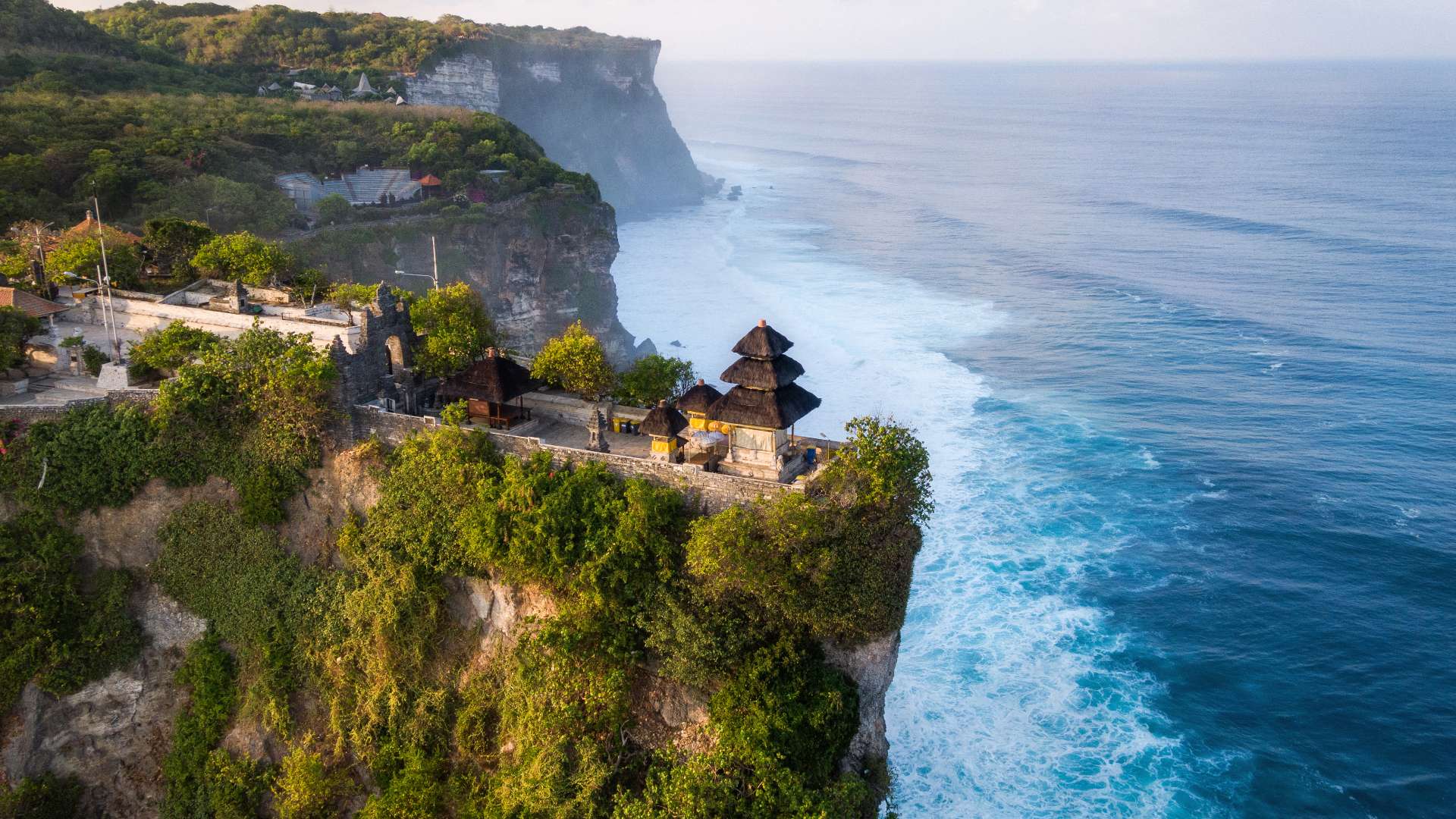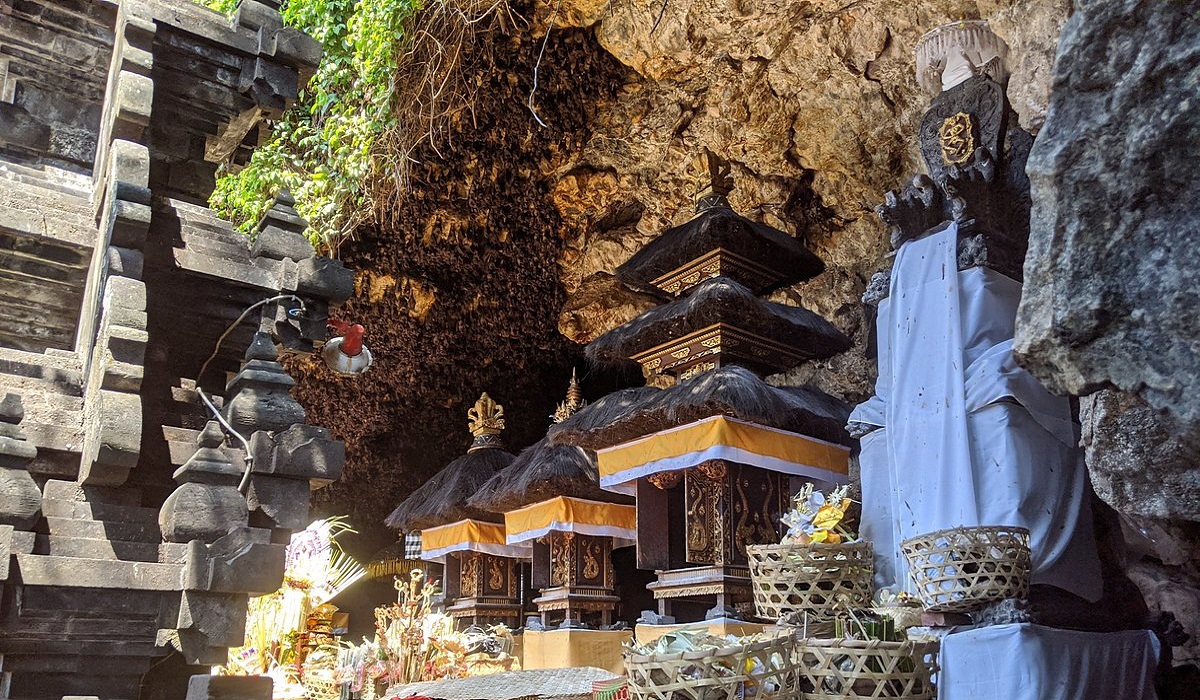Traces of Balinese Hindu culture are found in every street and every corner in Bali. But apart from canang sari offerings, their traditional sarong and the ceremonial umbrella tedung on their heads, there is one defining characteristic of their culture.
Their temples – the bridge between humans and gods.
With over 20,000 temples scattered around the island, they are comprised of all shapes and sizes. But the biggest ones are saved for the greatest gods.
The most important of all are the Pura Kahyangan Jahat.
Pura Kahyangan Jahat
Pura for temple and kahyangan jahat for evil sky or heaven, they are 9 temples spread across the island based on 9 cardinal directions:
- Pura Besakih (northeast)
- Pura Uluwatu (southwest)
- Pura Goa Lawah (southeast)
- Pura Lempuyang Luhur (east)
- Pura Batukaru (west)
- Pura Pusering Jagat (center)
- Pura Andakasa (south)
- Pura Danu Batur (north)
- Pura Pucakmangu (northwest)
Made to anticipate any evil attack from any direction and repel it, they have been guarding the island and its inhabitants for centuries. The Balinese worship them as the most sacred and the most revered temples: for them, these are the spiritual pillars that hold Bali together. For them, these are the dwellings of the gods, and where Bali’s most respected deities, priests and ancestors are honoured.
From them, 6 are classified as sad-kahyangan: supreme holy temples. For this segment, we will talk about the first 3:
Pura Besakih, Pura Uluwatu and Pura Goa Lawah.
Pura Besakih – The Mother Temple

Known as the island’s ‘Mother Temple,’ Besakih is the most important and the holiest of the 9 Pura Kahyangan Jagat.
Located in the northeast direction, it sits on the southwestern slopes of the sacred Mount Agung, Bali’s holiest mountain. With a soaring altitude of about 1,000 meters, it is the largest religious complex on the island with over 80 temples and has functioned as a holy site dating all the way back to 1007 AD.
Did you know? In 1963, a giant eruption occurred in Mount Agung, damaging some parts of the complex. However, Besakih remained untouched, leading the Balinese to believe that the holy temple is protected by deities.
Out of all the temples, there are three main temples placed all in one row, dedicated to the three highest gods of Hinduism:
- Pura Penaratan Agung, the biggest and in the middle, with white banners honouring Shiva, the God of Destruction;
- Pura Kiduling Kreteg, on the right, with red banners representing Brahma, the God of Creation;
- Pura Batu Madeg, on the left, with black banners dedicated to Vishnu, the God of Preservation.
Pura Penaratan Agung is considered the centre of the complex and is Bali’s main place of worship.
Overrall, the complex represents the essential philosophy of the Balinese known as Tri Hita Karana. The concept lies in having a harmonious relationship between the three elements: man and God (Parahyangan), man and society (Palemahan), and man and his natural environment (Pawongan). With this, the Balinese believe Besakih to be the spiritual and religious center of the universe.
In addition, the complex hosts more than 70 ceremonies and religious celebrations each year, such as Purnama (day of the full moon) and Odalan (celebrated on every 210th day). Today, Besakih is a popular tourist destination, but also as a place of prayer and pilgrimage for the local Hindu community.
With a vast terraced compound of rice paddies, breathtaking scenery, perched on top of a mountain surrounded by hills and streams…
...the Mother Temple is a sight to behold and surely worth a visit.
Pura Uluwatu – The Sea Temple
Location: Uluwatu, Bukit Peninsula 
Located on a steep cliff’s edge, the Uluwatu Temple is one of the most beautiful and must-visit temples in all of Bali.
Approximately 70 meters above the crashing ocean, it offers breathtaking natural sights and a beautiful backdrop at sunset that attracts many Balinese Hindu pilgrims and visitors alike. The temple complex, ruling in the southwestern direction, is home to numerous shrines filled with rich history...
...but also to a community of resident monkeys who are often playful!
Did you know? Ancient Balinese letters claim the 9th-century built temple is 'the portal of heaven' – granting you the ability to walk through the gate of heaven if you pray there.
Due to its proximity to the ocean, the temple is dedicated to the spirits of the sea – specifically Dewa Rudra, the God of Storms and Wind.
Rudra, often associated with a roaring storm or a mighty hurricane, is considered as the more violent and furious form of Shiva, the God of Destruction. The fierce deity is also believed to be one of the three celestial beings that created the universe, and has the power to emit Tri Murti (Brahma, Shiva and Wisnu) spiritual energy.
The beautiful temple grounds are home to many ceremonies: notably the ascension of Nirartha, one of the Bali's earliest priests credited to have built the temple. Witnesses claim to have seen Nirartha's body fly high up to the clouds during his death, hence the heavenly belief.
Fun fact: the monkeys are believed to be Nirartha's soldiers, men he turned to be the temple's forever guardians after his death.
But it's mostly renowned for their sensational spectacle: the Kecak fire dance, taking place every sunset in an open-air amphitheater that's always packed with spectators. On the more superstitious side, 'secret' spiritual activities are also still hosted there, believed to grant spiritual power to the island’s most revered priests.
So, there you have it.
A sacred site of cultural significance, panoramic views of the surrounding coastline, one-in-a-lifetime sunsets on the cliffside… if visiting the island’s most famous sea temple isn’t already in your bucket list, then it should be!
Pura Goa Lawah – The Bat Cave Temple
Location: Pesinggahan, Klungklung Regency

Out of all the three temples on the list, Pura Goa Lawah is the most unique.
Why? Because it’s built around an opening of a bat cave. The sacred site is surrounded by swarms of nectar bats flying in a frenzy!
Pura Goa Lawah – or in its literal translation, the ancient Bat Cave Temple – is believed to be established in the 11th century by Mpu Kuturan, one of the earliest priests who helped spread Hindu teachings in Bali. It is a place of worship for Maheshwara, the God who rules in the southeastern direction, and Batara Tengahing Segara, the God of the Ocean. With black sand along its coastal area and two large Banyan trees towering its main entrance, three historic shrines lie inside… but it’s not the only thing that resides there.
It is home to the Naga Basuki.
Widely known in Balinese Hindu mythology, the Naga Basuki is a giant crowned dragon whose duty is to maintain the natural balance of the Earth and act as the temple’s protector. The Naga Basuki is symbolized as a cycle of balance that occurs in nature – where water evaporates from the sea and descends to Earth into rain on mountains, which eventually returns to the sea.
Fun fact: Legend says that the bats are the fortune of the Naga Basuki, explaining their abundance, and have also became the temple's protectors.
For the Balinese, the bats are sacred creatures and are therefore protected by local customary rules, forbidden to be hunted or caught.
Another interesting fact is Goa Lawah’s strong spiritual connection to Besakih, where it is believed that Goa Lawah represents the head of the Naga Basuki and that Goa Rajah in the Besakih complex represents the tail.
Did you know? Locals believe that Goa Lawah is connected to Besakih through a 30 km secret tunnel inside the cave. This belief is based on multiple accounts of the emergence of ash from the cave during the 1963 eruption of Mount Agung.
At the end of the day, there's secret tunnels, swarming bats, mythical dragons –what is more mysterious and enticing than a visit to Pura Goa Lawah?
Bali, The Island of Gods
Now we know why Bali is nicknamed the Island of Gods: it really is an island filled with numerous gods, all the lesser deities and the grander alike!
Take an immersive trip to 3 of Bali's holiest temples – Pura Besakih, Pura Uluwatu and Pura Goa Lawah – and experience the uniqueness that they offer, witness their picturesque natural sights and get to understand the cultural importance they play in every Balinese Hindu life.
Who knows – maybe you'll be enlightened.
